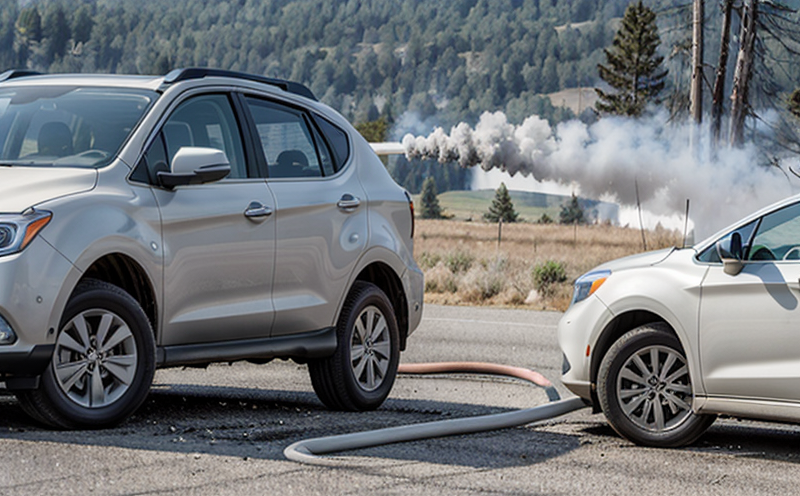Toxic Gas Analysis for Aerospace Materials
In the aerospace industry, material selection is critical due to the demanding operating environment. The materials used in aircraft and spacecraft must not only withstand extreme temperatures, pressures, and mechanical stresses but also be safe when exposed to various toxic gases that can be generated during emergencies or failures. Toxic gas analysis plays a crucial role in ensuring the safety of passengers, crew, and the integrity of the vehicle itself.
The primary focus of this service is on identifying and quantifying toxic gases emitted by materials used in aerospace applications. This includes gases such as carbon monoxide (CO), hydrogen cyanide (HCN), formaldehyde (HCHO), acetaldehyde (CH₃CHO), and other potentially harmful substances that can be released during combustion or under high-temperature conditions.
Our laboratory uses advanced analytical techniques to determine the levels of these gases, ensuring compliance with international standards such as ISO 17872-3:2019 for smoke density testing. The service is designed to support the aerospace industry in meeting stringent safety and quality requirements, thereby protecting personnel and equipment.
The process begins with careful selection of specimens that are representative of the materials used in various parts of an aircraft or spacecraft. These specimens undergo rigorous preparation to ensure they accurately reflect real-world conditions. Once prepared, these samples are subjected to controlled combustion tests under specified conditions, simulating potential failure scenarios.
Our laboratory employs state-of-the-art equipment and software to analyze the gases produced during the combustion process. This includes high-resolution gas chromatographs (GC) and mass spectrometers (MS), which provide precise measurements of all relevant toxic compounds. The data collected is then compared against predefined acceptance criteria, ensuring that any emissions are within acceptable limits.
The results from these analyses can be used to identify problem areas in material selection or design, leading to improvements in safety and performance. This information is invaluable for quality managers and R&D engineers working on new materials or modifications to existing designs. By identifying potential hazards early in the development process, we help prevent costly delays and ensure compliance with regulatory requirements.
Our service not only meets but exceeds industry expectations by providing comprehensive reports that go beyond simple pass/fail determinations. These detailed reports include recommendations for improvements where necessary, along with insights into how different materials perform under various conditions. This level of transparency helps procurement teams make informed decisions about which suppliers to partner with and ensures that all stakeholders have the information they need to ensure safety.
| Step | Description |
|---|---|
| Sample Preparation | The selected specimens are cut into small, uniform pieces to ensure consistent testing conditions. |
| Combustion Testing | Specimens are exposed to controlled combustion in airtight chambers designed to simulate real-world failure scenarios. |
| Gas Analysis | Toxic gases are captured and analyzed using advanced GC-MS equipment for precise quantification. |
| Reporting | Detailed reports are generated, including raw data, analysis results, and recommendations for improvement. |
Scope and Methodology
The scope of our toxic gas analysis service for aerospace materials encompasses a comprehensive evaluation of the gases produced by various types of materials used in aircraft and spacecraft. This includes both synthetic polymers and natural fibers, as well as composite materials that combine these elements. The testing process is designed to mimic real-world conditions where these materials might encounter extreme temperatures or exposure to fire.
- Sample Selection: Specimens are chosen based on their intended use within the aerospace industry, ensuring they represent typical operating environments.
- Preparation: Samples undergo thorough cleaning and trimming to maintain consistency across all test runs.
- Combustion Simulation: Controlled combustion tests simulate potential failure scenarios in a safe environment.
- Data Collection: Advanced instrumentation captures detailed information about the gases released during testing.
Industry Applications
The aerospace industry relies heavily on materials that can withstand extreme conditions while remaining safe for use in pressurized cabins. Toxic gas analysis is essential for ensuring these materials do not pose a risk to human health or compromise structural integrity during emergencies.
- Materials Testing: Identifying the types and levels of toxic gases emitted by various materials helps engineers design safer aircraft interiors.
- Safety Compliance: Ensuring compliance with international standards like ISO 17872-3:2019 ensures that products meet regulatory requirements.
- R&D Support: Analyzing the performance of new materials under controlled conditions aids in continuous improvement efforts.
- Supply Chain Management: Providing data on material safety allows procurement teams to make informed decisions about suppliers and product specifications.
Customer Impact and Satisfaction
By offering toxic gas analysis services specifically tailored for aerospace materials, we contribute significantly to the overall safety and reliability of aircraft and spacecraft. Our customers benefit from:
- Enhanced Safety: Identifying potential hazards early in the development process ensures that only safe materials are used.
- Regulatory Compliance: Ensuring that all products meet stringent safety and quality standards.
- Improved Product Quality: Continuous improvement based on test results leads to better-performing materials.
- Reduced Risk: By mitigating risks associated with toxic gas emissions, we help prevent costly accidents and incidents.
We are committed to providing high-quality services that exceed customer expectations. Our team of experts works closely with each client to understand their specific needs and deliver customized solutions. This dedication has earned us a reputation for excellence in the aerospace sector.





